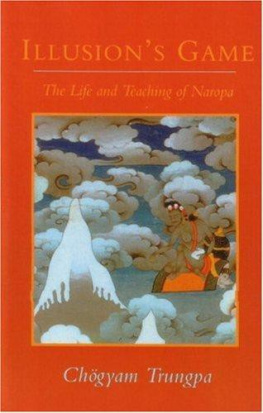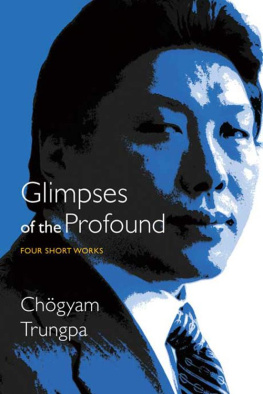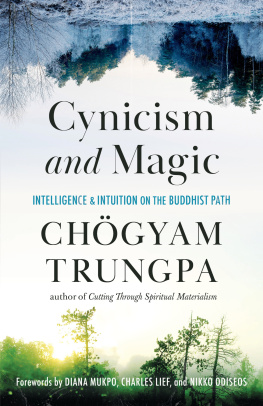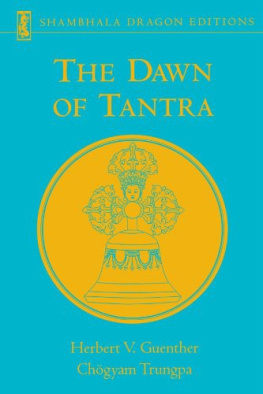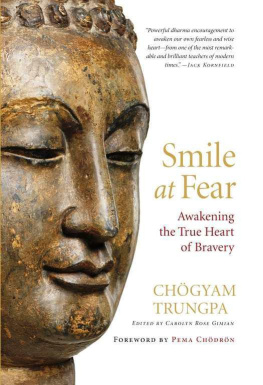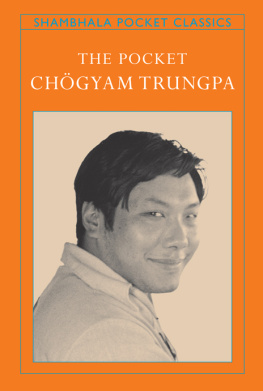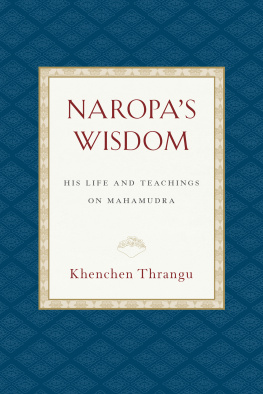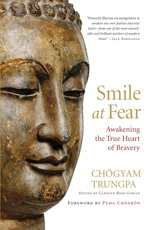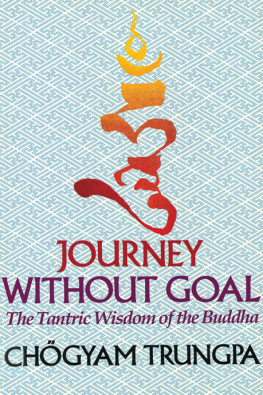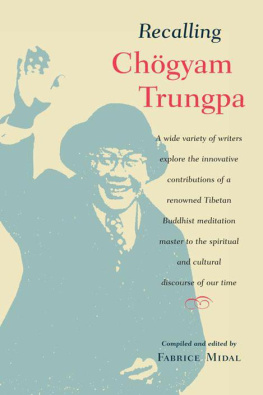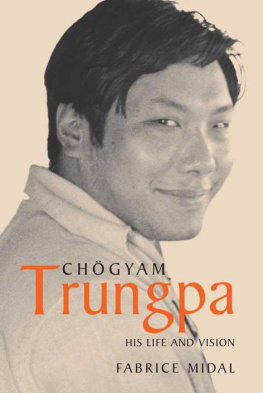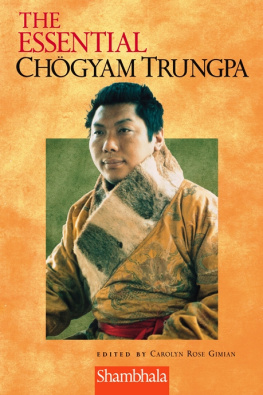Illusions Game
THE LIFE AND TEACHING OF NAROPA

Chgyam Trungpa
Edited by Sherab Chdzin

Shambhala Boston & London 2010
S HAMBHALA P UBLICATIONS , I NC .
Horticultural Hall
300 Massachusetts Avenue
Boston, Massachusetts 02115
www.shambhala.com
1994 by Diana J. Mukpo
All rights reserved. No part of this book may be reproduced in any form or by any means, electronic or mechanical, including photocopying, recording, or by any information storage and retrieval system, without permission in writing from the publisher.
LIBRARY OF CONGRESS CATALOGING-IN-PUBLICATION DATA
Trungpa, Chgyam, 1939
Illusions game: the life and teaching of Naropa / Chgyam Trungpa: edited by Sherab Chdzin.1st ed.
p. cm.(Dharma ocean series)
Includes index.
eISBN 978-0-8348-2136-1
ISBN 0-87773-857-2
1. Naapda. 2. Yoga (Tantric Buddhism) I. Chdzin, Sherab II. Series: Trungpa, Chgyam, 1939 Dharma ocean series.
BQ7950.N347T78 1994 | 93-39383 |
294.3925092dc20 | CIP |
BVG 01 |
Contents
Editors Foreword
T HIS BOOK IS composed of two seminars by the Vidyadhara, the Venerable Chgyam Trungpa Rinpoche, on the life and teachings of Naropa. Naropa, an Indian of the eleventh century, was one of the Vidyadharas own spiritual forefathers and a seminal figure for the vajrayana Buddhism of Tibet. The Vidyadhara gave a number of seminars on Naropa, each with its own flavor and emphasis. The editor has had to make a more or less arbitrary selection from them for this volume (New York, January 1972, four talks; Tail of the Tiger, Vermont, 1973, six talks). Future volumes, we hope, will complete the availability to the public of the Vidyadharas teaching on the very profound subject matter surrounding the life of Naropa.
Great Vajradhara, Telo, Naro, Marpa, Mila; lord of dharma, Gampopa.... So begins the supplication to the lineage of enlightened teachers of the Kagy, one of the four main orders of Buddhism in Tibet. Vajradhara is the dharmakaya buddha, the ultimate repository of awakened mind. Telo is Tilopa, a great Indian siddha, Naropas guru, the first human in the lineage. Naro is Naropa, who became the guru of Marpa, the first Tibetan in the lineage. Marpas disciple was Mila, the renowned Tibetan yogi usually known as Milarepa (Mila the cotton clad). Milarepas leading disciple, Gampopa, founded the monastic order of the Kagy, the various branches of which have been headed by Gampopas successors for the last nine hundred years.
In the vajrayana Buddhism of Tibet, the central event, which remains timelessly new through the generations, is the transmission of the awakened state of mind from guru to disciple through a meeting of minds. As the awakened state itself is independent of word, concept, or thought, the transmission of it is beyond process. Nevertheless it happens in peoples lives, and an extraordinarily demanding process of preparation seems to be needed for students to reach the spiritual nakedness that enables them to open directly to the gurus mind. This process, as we see from Naropas story, is one that requires of the student an extreme level of self-surrender and in which the teacher sometimes resorts to extremely brutal means to break him and strip him down. Doubtless to the workaday world, such a process, with its outrageous suffering, may seem insane. Yet, seen with the greater vision of enlightenmenthere spoken of in terms of mahamudra, the great sealthis process is the utmost expression of compassion and sanity. The tale of how Naropa came into direct communication with Tilopa and received from him the transmission of awakened mind became a paradigm for the later tradition of vajrayana Buddhism in Tibet, which arose out of their relationship.
Naropas story makes it possible to delineate in very concrete terms the various levels of spiritual development that lead up to the possibility of meeting the gurus mind. This is the main thrust of the Vidyadharas presentation to Western studentsmaking them see themselves and their potentialities in Naropa and his journey. In this manner he opens to them the path of devotion and surrender to the guru as the embodiment and spokesman of reality.
The Vidyadhara deals only briefly here with the formal mahamudra teachings and other tantric teachings associated with Naropas name, notably, the six dharmas of Naropa (Tib. naro chdruk ), or six Naropa yogas, as they are sometimes called. But in his concise descriptions, particularly in the later part of the book, he catches each one by its experiential essence, conveying in a few simple words an insight that students might well seek in vain elsewhere through hundreds of pages of text or many hours of oral teaching.
The students to whom the Vidyadhara gave these talks were asked to read The Life and Teaching of Naropa , the twelfth-century biography translated from Tibetan by the eminent scholar Herbert V. Guenther (Boston: Shambhala Publications, 1986). Reading this book might be a help for readers of the present volume. Nevertheless, the summary of it that follows and the citations and references in the text convey the essentials. Moreover, occasional references and descriptions by the Vidyadhara reveal that he was sometimes referring in his own mind to at least one other version of Naropas life story.
Naropa lived in northern India in the eleventh century. He was the only son of a royal family. From an early age, he devoted himself single-mindedly to spiritual matters. His mind was filled with compassion for beings, and his primary interest was the study and practice of the buddhadharma. In his youth, in view of his parents strong desire for the continuity of their royal line, Naropa consented to marry. However, after eight years he was once more overcome by his desire to devote himself exclusively to the dharma. His wife, Niguma, agreed to a divorce and became his disciple (and later a great teacher). Naropa entered the great Buddhist monastic university of Nalanda. There he greatly developed his intellectual powers and became extremely learned. So great were his intellectual powers and erudition that he was elevated to the abbacy of Nalanda. He became renowned as the premier teacher of Buddhism of his time.
At this point in his life (at around the age of forty), the event occurred that was to make Naropa of interest to the tantric tradition. One day, as he was reading with his back to the sun (a symbolic description of his spiritual relationship to reality at that time), he had a vision of a very ugly woman, who told him he understood only the words in his book, not their real meaning. She also revealed that the only way to discover the real meaning was to seek a guru, her brother Tilopa (see pages 160161 for a quotation of this passage). Over the sustained and impassioned objections of the masters and students of Nalanda, who begged Naropa not to leave and deprive them of their guiding light, Naropa departed from the great university and began his lonely journey in search of Tilopa.
This journey turned out to be arduous and daunting in the extreme. Naropa encountered, instead of Tilopa himself, eleven hideous visions (see pages 163169 for a quotation describing this part of the story). Naropa was about to kill himself when Tilopa finally appeared and accepted him as his student. Tilopa showed Naropa a series of symbols, which Naropa understood. Tilopa then sat motionless for a year. At the end of a year, Tilopa made a slight movement, which provided a pretext for Naropa to prostrate and ask for teaching. Tilopa required him to leap from the roof of a tall temple building. Naropas body was crushed. He suffered immense pain. Tilopa healed him with a touch of his hand, then gave him instruction.
Next page
